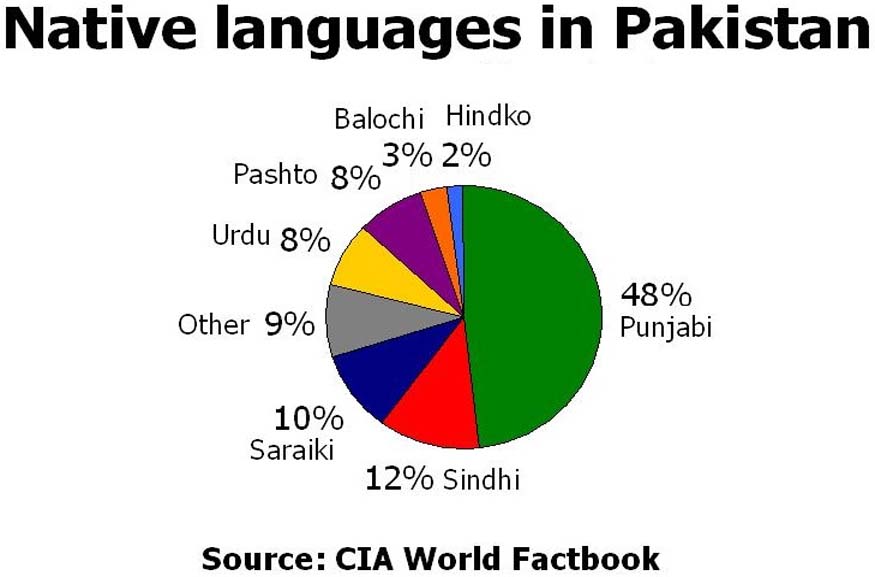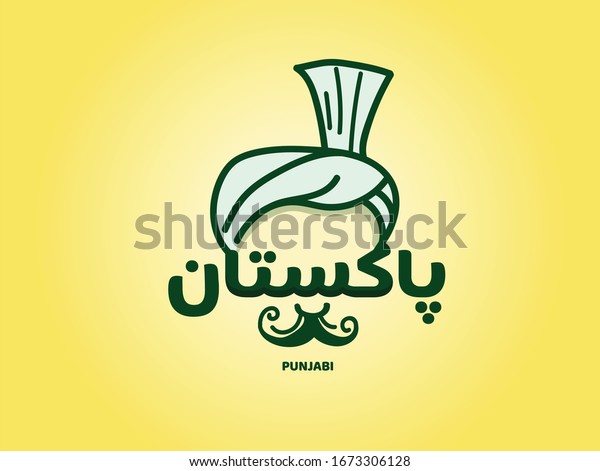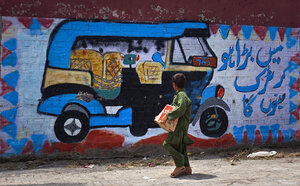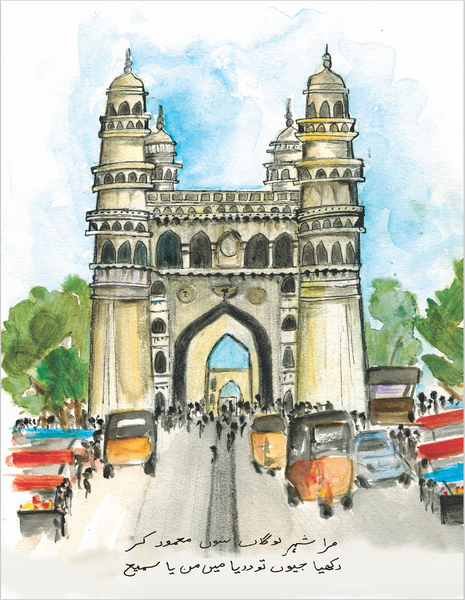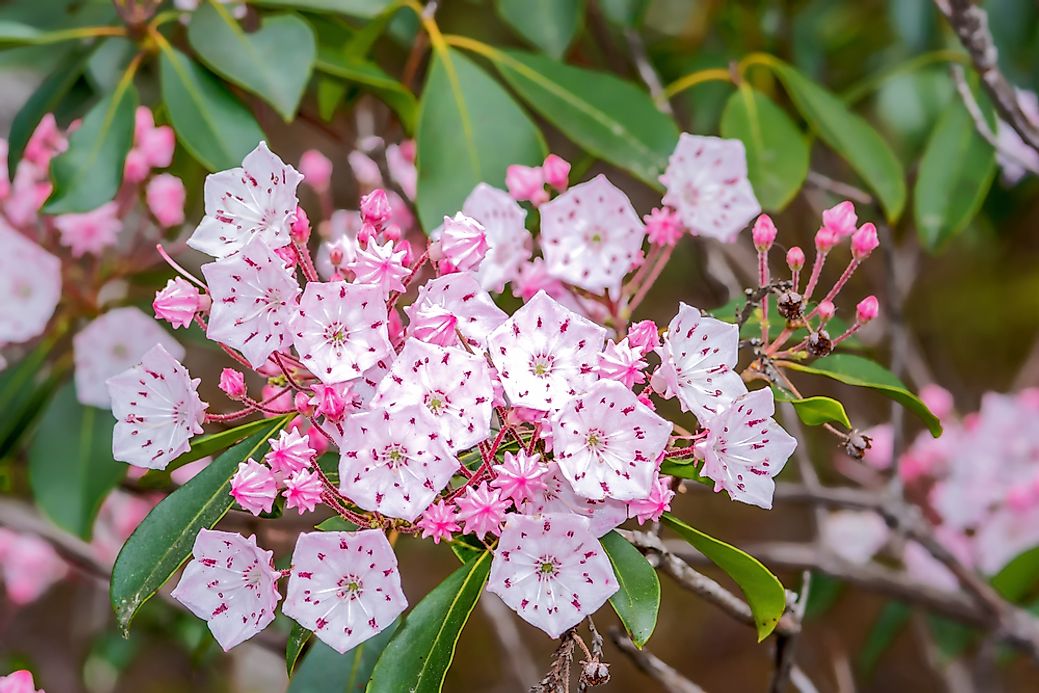Hindi and Urdu are generally considered to be one spoken language with two different literary traditions. That means that Hindi and Urdu speakers who shop in the same markets have no problems understanding each other -- they'd both say yeh kitne kaa hay for 'How much is it? And the Urdu one will be یہ کتنے کا ہے؟ Hindi is written from left to right in the Devanagari script, and is the official language of India, along with English. Urdu, on the other hand, is written from right to left in the Nastaliq script and is the national language of Pakistan. It's also one of the official languages of the Indian states of Bihar and Jammu & Kashmir. Considered as one, these tongues constitute the second most spoken language in the world, sometimes called Hindustani.
In their daily lives, Hindi and Urdu speakers communicate in their 'different' languages without major problems. Both Hindi and Urdu developed from Classical Sanskrit, which appeared in the Indus Valley at about the start of the Common Era. The first old Hindi poetry was written in the year 769 AD, and by the European Middle Ages it became known as 'Hindvi'.
Muslim Turks invaded the Punjab in 1027 and took control of Delhi in 1193. They paved the way for the Islamic Mughal Empire, which ruled northern India from the 16th century until it was defeated by the British Raj in the mid-19th century. It was at this time that the language of this book began to take form, a mixture of Hindvi grammar with Arabic, Persian and Turkish vocabulary. The Muslim speakers of Hindvi began to write in the Arabic script, creating Urdu, while the Hindu population incorporated the new words but continued to write in Devanagari script. In India, although Urdu is not and never was used exclusively by Muslims , the ongoing Hindi–Urdu controversy and modern cultural association of each language with the two religions has led to fewer Hindus using Urdu. In part because the Pakistani government proclaimed Urdu the national language at Partition, the Indian state and some religious nationalists began to regard Urdu as a 'foreign' language, to be viewed with suspicion.
Urdu, which was often referred to by the British administrators in India as the Hindustani language, was promoted in colonial India by British policies to counter the previous emphasis on Persian. Urdu replaced Persian as the official language of India in 1837 and was made co-official, along with English. In the Delhi region of India the native language was Khariboli, whose earliest form is known as Old Hindi . It belongs to the Western Hindi group of the Central Indo-Aryan languages. The contact of the Hindu and Muslim cultures during the period of Islamic conquests and in the Indian subcontinent led to the development of Hindustani as a product of a composite Ganga-Jamuni tehzeeb.
In cities such as Delhi, the Indian language Old Hindi began to acquire many Persian loanwords and continued to be called "Hindi" and later, also "Hindustani". In southern India , a form of the language flourished in medieval India and is known as Dakhini, which contains loanwords from Telugu and Marathi. An early literary tradition of Hindavi was founded by Amir Khusrau in the late 13th century.
From the 13th century until the end of the 18th century the language now known as Urdu was called Hindi, Hindavi, Hindustani, Dehlavi, Lahori, and Lashkari. The name Urdu was first introduced by the poet Ghulam Hamadani Mushafi around 1780. As a literary language, Urdu took shape in courtly, elite settings.
While Urdu retained the grammar and core Indo-Aryan vocabulary of the local Indian dialect Khariboli, it adopted the Nastaleeq writing system – which was developed as a style of Persian calligraphy. The first language of around 70 million people and spoken as a second language by over 100 million people, mostly in Pakistan and India, in the world, Urdu is one of the oldest and most popular members of the Indo-European family of languages. The history of the Urdu language dates back to as early as the 12th century AD. Widely spoken and understood across the globe, it is the national language of Pakistan whereas English remains the official language of the state. By the 19th century, poetry written in Urdu was stimulated by socialist nationalist, pan-Islamic feeling, and writers and poets from the Punjab as well as the areas of Delhi and Lucknow began to contribute. Urdu is the official language of Pakistan and is widely spoken in six states of India.
There are more than 40 million people in the world who speak Urdu, and almost twice of them are native speakers. As the mother tongue of one of the oldest and most fascinating regions globally, its influence is far-reaching and ever-changing. Furthermore, it is the language of countless literary works, from prose and poetry to philosophy and literature. Learn Urdu and embark on a fascinating journey through one of the most complex and delicate cultures of our time. In 1973, Urdu was recognised as the sole national language of Pakistan – although English and regional languages were also granted official recognition. SOON after the partition of the subcontinent into India and Pakistan, especially after India had taken Hindi as the official language, central leaders of Pakistan wanted Urdu to be the sole state language of entire Pakistan.
This is a decision which had been strongly opposed by the people of East Pakistan. With the utmost surprise of the history of the language movement, Urdu itself has never been the most widely spoken language of Pakistan till now. During the movement, it was the language of only 7 per cent of the total population of Pakistan while Bangla accounted for 54 per cent.The mother tongue of most of the West Pakistanis were Panjabi, Pashtu, Sindhi, Balochi and so on. Some who are from a non-Urdu background now can read and write only Urdu. With such a large number of people speaking Urdu, the language has acquired a peculiar Pakistani flavour further distinguishing it from the Urdu spoken by native speakers, resulting in more diversity within the language. Urdu is the sole national, and one of the two official languages of Pakistan .
It is spoken and understood throughout the country, whereas the state-by-state languages are the provincial languages, although only 7.57% of Pakistanis speak Urdu as their first language. Its official status has meant that Urdu is understood and spoken widely throughout Pakistan as a second or third language. It is used in education, literature, office and court business, although in practice, English is used instead of Urdu in the higher echelons of government. Article 251 of the Pakistani Constitution mandates that Urdu be implemented as the sole language of government, though English continues to be the most widely used language at the higher echelons of Pakistani government.
Punjabi, Saraiki and Pashto are languages spoken in Punjab and Khyber PakhtunkhwaPunjabi, which often spelled as Panjabi, is counted among the most common Indo-Aryan languages in today's world. In Pakistan, Punjabi language is spoken by around 70 million souls, mostly in Punjab province. However, the status of the official language of Punjab is reserved for Urdu. As spoken in both India and Pakistan, Punjabi is a language of many dialects. Written in Gurmukhi and Shahmukhi scripts, the dialects of the language doesn't have much difference between them and sound quite similar.
Dialects of Punjabi spoken in India are Majhi, Doabi, Pwadhi and Malwi. However, in Pakistan, the chief dialects are Pothohari, Hindko, Majhi and Multani. Since Majhi is used to form the standard for writing in Punjabi, it is considered the most important dialect of Punjabi in the country.
Urdu as a language evolved during the last days of the Mughal rule in India. Persian was the official language of the Mughal emperors along with Turkic and Arabic. At that time, the northern part of India was the centre of rule and knowledge, particularly Delhi and its surrounding areas, including today's Bihar and Uttar Pradesh. Due to the interaction of local population and the ruling Persian-Turkic-speaking Muslim elite, a new language evolved and was known as Hindustani. So, Urdu became one of the signs of era of prosperity and power of the Muslims in this sub-continent.
Urdu is not only the official language of Pakistan but also the national language of the country. However, only about 8% of Pakistanis speak Urdu as their first language. However, a vast section of the population speaks it as their second language. The origin of Urdu goes back several centuries, and according to some historians, Urdu has evolved from an Indo-Aryan language spoken in the area around Delhi which absorbed words from Arabic, Persian, and Chagatai. The Government of Pakistan has strived to promote the national language of Pakistan to encourage national solidarity. Although Urdu is the official national language, it is spoken as a native tongue by only 8 percent of the population.
People who speak Urdu as their native language generally identify themselves as muhajirs. A large number of people from educated backgrounds speak Urdu, as opposed to their natal languages, in their homes, usually to help their children master it. Although it is considered to be predominantly inhabited by Urdu-speaking people, the city of Karachi is the most linguistically diverse city in Pakistan. Being the county's most populated city, one finds a remarkable treasure trove of languages here.
If the latest census results hold any meaning, the percentage of the Urdu-speaking population in Karachi has rather been decreasing with the influx of people speaking other languages. No region in Pakistan uses Urdu as its mother tongue, though it is spoken as the first language of Muslim migrants in Pakistan who left India after independence in 1947. Urdu was chosen as a symbol of unity for the new state of Pakistan in 1947, because it had already served as a lingua franca among Muslims in north and northwest British India. It is written, spoken and used in all provinces/territories of Pakistan, although the people from differing provinces may have different native languages.
It has official status in the Indian states of Andhra Pradesh, Delhi, Jammu and Kashmir, and Uttar Pradesh where it is used in government administration and as the medium of instruction in primary schools. Throughout India, Urdū is typically spoken by Moslems, whereas Hindi is typically spoken by Hindus. Urdu uses a modified form of Perso-Arabic script known as Nastaliq (nastaʿlīq).
According to research done in 2021 estimates, Urdu is the 21st most spoken first language in the world, with approximately 61.9 million who speak it as their native language. According to Ethnologue's 2018 estimates, Urdu is the 10th most widely spoken language in the world with 230 million total speakers, including those who speak it as a second language. Pashto, the official language of neighboring Afghanistan, also has a significant number of speakers in Pakistan. This language of Pakistan is spoken by over 15.42% of the entire population of the country.
The Pashto speakers are concentrated in northern Balochistan, Federally Administered Tribal Areas, and Khyber Pakhtunkhwa regions of Pakistan. Pashtun communities in the cities of the country also speak this language. Pashto has a rich literary tradition, and some famous poets who used the Pashto language in their literary work are Khushal Khan Khattak, Rahman Baba, Khatir Afridi, and Ghani Khan. There are 63,784 people in Karachi, according to the 2017 census results, who call Kashmiri as their mother tongue. The Kashmiri-speaking people comprise 0.39 per cent of the total population of the city. Historically, Hindustani developed in the post-12th century period under the impact of the incoming Afghans and Turks as a linguistic modus vivendi from the sub-regional apabhramshas of north-western India.
Its first major folk poet was the great Persian master, Amir Khusrau (1253–1325), who is known to have composed dohas and riddles in the newly-formed speech, then called 'Hindavi'. Through the medieval time, this mixed speech was variously called by various speech sub-groups as 'Hindavi', 'Zaban-e-Hind', 'Hindi', 'Zaban-e-Dehli', 'Rekhta', 'Gujarii. 'Dakkhani', 'Zaban-e-Urdu-e-Mualla', 'Zaban-e-Urdu', or just 'Urdu'.
By the late 11th century, the name 'Hindustani' was in vogue and had become the lingua franca for most of northern India. A sub-dialect called Khari Boli was spoken in and around Delhi region at the start of 13th century when the Delhi Sultanate was established. Khari Boli gradually became the prestige dialect of Hindustani (Hindi-Urdu) and became the basis of modern Standard Hindi & Urdu.
Mutual intelligibility decreases in literary and specialised contexts that rely on academic or technical vocabulary. In a longer conversation, differences in formal vocabulary and pronunciation of some Urdu phonemes are noticeable, though many native Hindi speakers also pronounce these phonemes. At a phonological level, speakers of both languages are frequently aware of the Perso-Arabic or Sanskrit origins of their word choice, which affects the pronunciation of those words.
Urdu speakers will often insert vowels to break up consonant clusters found in words of Sanskritic origin, but will pronounce them correctly in Arabic and Persian loanwords. As a result of religious nationalism since the partition of British India and continued communal tensions, native speakers of both Hindi and Urdu frequently assert that they are distinct languages. Hindko is another ancient language spoken in Pakistan that belongs to the group of Indo-Aryan languages. The speakers of Hinko are Hindkowan people, mostly living in the northern areas of Pakistan. According to linguistic experts, the name of the language is actually a merger of two words where "Hind" means Sindh and "ko" means language. As per the historical records, when the invaders came from Afghanistan to this area, they gave this name to the local language, which was being spoken from Peshawar to UP at that time.
There has been a debate about Hindko as some people consider it as a dialect of Sindhi while others call it one of the lesser known dialects of Punjabi language. Even though India and Pakistan became independent from England in 1947, English continues to play such a major social and educational role that education in English is a prerequisite for social status in both countries. English remains the sole language of higher education in almost every field of learning, and code-switching between Hindi/Urdū and English is extremely common, especially among the educated elite. English continues to be a necessity for Pakistan, a country where the majority of the people speak Punjabi and where a large number of other languages are used on a daily basis. The Persians used it to refer to the Indian people and to the languages they spoke. Scholars postulate that Hindi developed in the 8th-10th centuries from khari boli , spoken around Dehli and adopted by the Moslem invaders to communicate with the local population.
Eventually, it developed into a variety called Urdū (from Turkish ordu 'camp'), characterized by numerous borrowings from Persian and Arabic, which became a literary language. In the meantime, the language of the indigenous population remained relatively free of borrowings from Persian and Arabic, and instead borrowed words and literary conventions from Sanskrit. With some minor adjustments, this is probably true of today's Pakistan, too. While Punjabi, Sindhi, Pashto, Balochi, Seraiki, Hindko, etc, remain the main, in some cases the only, languages in the villages where their respective speakers live; urban Pakistan mostly, if not entirely, converses in Urdu of various tints and hues. " … The mother tongue of a very big ethnological minority happens to be Urdu and this community is as deeply attached to Urdu as every old Sindhi is attached to Sindhi. Moreover, Urdu has been declared the national language of Pakistan and the provincial language in the Punjab, NWFP and Balochistan," is how leftist intellectual Sibte Hasan wrote about the origin of the riots in the Herald's August 1972 issue.
The slogan for a separate province of Karachi, called Muhajiristan, was first raised in the wake of those riots, Hasan said. There are 63,784 people in Karachi, according to the 2017 census results, who say Kashmiri is their mother tongue. The Kashmiri-speaking people comprise 0.39% of the total population. South Asian Muslims have long felt that Urdu symbolizes their shared identity.
It has served as a link among educated Muslims and was stressed in the Pakistan independence movement. However, because many of the elite were fluent in English, English became the de facto national language. The push to elevate Urdu was unpopular in East Pakistan, where most of the population speaks Bengali and identifies with its literary heritage.
A highly Persianised and technical form of Urdu was the lingua franca of the law courts of the British administration in Bengal and the North-West Provinces & Oudh. Until the late 19th century, all proceedings and court transactions in this register of Urdu were written officially in the Persian script. Kaithi's association with Urdu and Hindi was ultimately eliminated by the political contest between these languages and their scripts, in which the Persian script was definitively linked to Urdu. Owing to interaction with other languages, Urdu has become localised wherever it is spoken, including in Pakistan. Urdu in Pakistan has undergone changes and has incorporated and borrowed many words from regional languages, thus allowing speakers of the language in Pakistan to distinguish themselves more easily and giving the language a decidedly Pakistani flavour.
Similarly, the Urdu spoken in India can also be distinguished into many dialects such as the Standard Urdu of Lucknow and Delhi, as well as the Dakhni of South India. Because of Urdu's similarity to Hindi, speakers of the two languages can easily understand one another if both sides refrain from using literary vocabulary. There have been attempts to purge Urdu of native Prakrit and Sanskrit words, and Hindi of Persian loanwords – new vocabulary draws primarily from Persian and Arabic for Urdu and from Sanskrit for Hindi. English has exerted a heavy influence on both as a co-official language. However, the style of Urdu spoken on a day-to-day basis in Pakistan is akin to neutral Hindustani that serves as the lingua franca of the northern Indian subcontinent. Various Urdu-speaking people, or Urdudaan (اردوداں), are spread across South Asia.
The historical centres of Urdu speakers include Delhi and Lucknow, as well as the Deccan. Hailed as the top tourist destination in the world for 2020, Pakistan is home to wondrous tourist gems, most of which haven't been explored yet. Some of the world's most famous travellers visited Pakistan recently and praised its incredible natural beauty as well as the hospitality of its people. The country also boasts a vibrant mix of different communities; its cultural and linguistic diversity is truly awe-inspiring. What's more amazing is that, according to Ethnologue, an international website, around 73 languages are spoken across the country, including some of the internationally recognised endangered languages. In this blog, we'll find out all about the most popular languages spoken in Pakistan.






